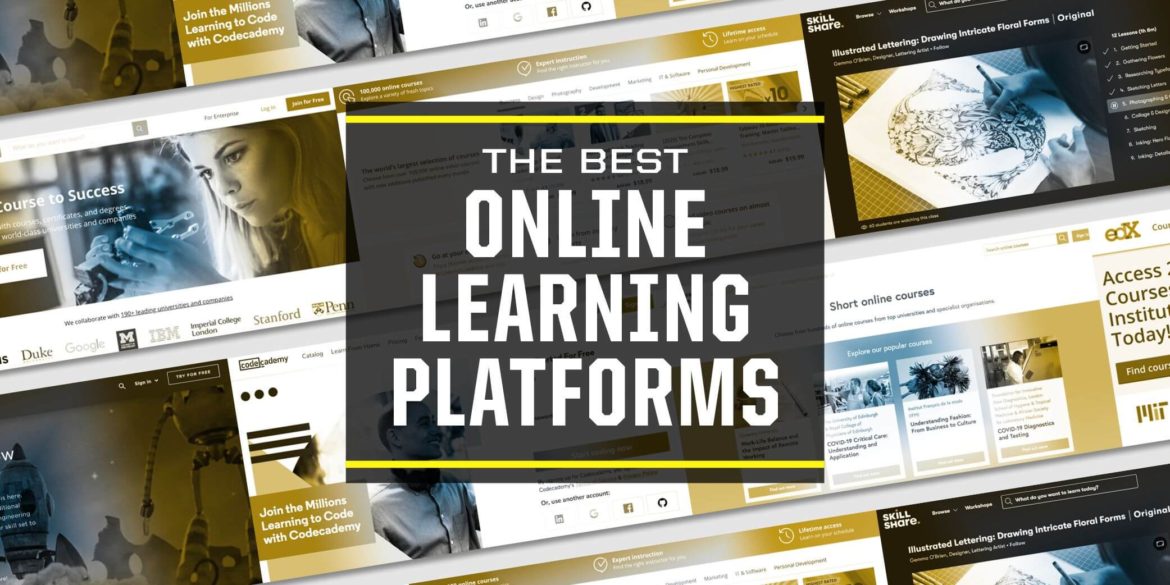Coursera, Skillshare, Udemy, Codecademy, Edx, Pluralsight, Future Learn and Moodle are some of the best online learning sites.
We also have online course networks including LearnWorlds, Teachable, Thinkific, Kajabi and Podia, in addition to online learning platforms.
Those, particularly following the advent of Covid-19, are leading a rapidly growing elearning industry. The growing number of individuals who are engaged in online learning for both learning and teaching purposes, either to learn a new ability or to teach online, is an unbreakable piece of evidence.
Fortunately, there are many sites for online learning and courses that provide the ability to train or build and sell courses online.
This is great news for online teachers, coaches, and future educators. But from the many choices out there the challenge to find the right online learning platform is real.
We also created a list of the best online learning platforms analyzed by style and category that you can use to deliver high-quality learning opportunities to help make this process simpler.
It is important to first differentiate between the two words’ online learning platforms and online course platforms ‘before we move forward, which sometimes gets blurred.
What is a Platform for Online Learning?
An online learning portal is an information system that offers a protected learning experience where online classes can be taken by students.
Such online learning sites are also referred to as online course markets’ because they give learners the chance to directly browse for and pay for online classes.
While some of these course markets are used to include online courses that you can build, most are more educational-based and strictly provide instruction at the university level.
In relation to a learning management system, what is an Online Course Platform?
An online course portal is a type of learning management system (LMS) that can be used to develop, host, distribute and sell online courses by online instructors. An LMS is the higher level commonly used for staff training and onboarding firms or teaching assistance by public institutions, but the entire category can also include course portals or also WordPress plugins used by SMEs to build and sell online courses.
Cloud-hosted apps, unlike online learning sites, allows teachers to create online courses or individual lessons by uploading instructional content they have developed using text, image, video, PDF, and audio.
In essence, individuals or SMEs, instead of offering their courses in a popular course marketplace like Udemy, Edx, MagnetBrains or SKillshare, can use a course platform to create their own course marketplace. This way, all the revenue and user data that will otherwise have no control over can be retained.
Platforms for Online Instruction Versus Online Course Platforms
An online learning platform illustrates and introduces the viewpoint of the learner, while an online course platform takes the online instructor/perspective. teacher’s
The two names are often used interchangeably, and using the definition and the context of the conversation, the real differences come from the individual. A learning portal is a place to discover instructional materials, browse and purchase courses or complete educational programs from the perspective of students. Whereas, from the viewpoint of an educator, it is the place to deliver knowledge.
Online learning platforms are also used to describe courses or education marketplaces such as Coursera, Udemy, and Lynda, while course platforms commonly refer to applications used to build a learning experience such as LearnWorlds, Thinkific, or Teachable.
On the other hand, you lose leverage of pricing, consumer records, and positioning by using an online learning network cuts off most of the hard work of creating an audience, promotion, and revenue.
You have more independence and freedom in the control of your learning tools while using an online course network. In the configuration and look of the entire website that hosts the online courses and the course itself, you even get to have a say in how it is viewed and marketed.
Basically, what you are going to pick comes down to your own specifications.
Top Course Site Our Choice: LearnWorlds
You will need to look at more technical criteria contained in a learning management system if you plan to go for a standalone course program. This is because there are several kinds of LMSs and each of them specializes or serves a certain function more than those of a certain genre.
A course portal provides an all-in-one approach that suits the criteria for entrepreneurs, course designers, training organisations, and SMEs.
LearnWorlds arrives straight out of the box with eCommerce features, course authoring, and website creation capability. And it’s the network that our team has been building and nurturing for the past 7 years, with thousands of customers trusting it to offer online learning in 80+ countries around the world!
Best Tools For Online Learning
We evaluate their benefits and drawbacks as we go through each learning platform to help you determine if it suits your criteria or not.
As we described before for learners looking to find a topic to review, learning platforms are more fitting. They have a large library of courses and routes for learning.
Any of them accept individual teachers to teach to authorize the material with varying conditions. If you don’t want to start a course on your own website, that’s the second best way to do it. For teachers to upload their material and how they monetize the materials, each has its own specifications.
However, for both students and instructors looking into these sites, we have provided pros, cons and detail.
#1 Platform: Learning on LinkedIn (Lynda)
LinkedIn Learning which was formerly Lynda.com, is an educational platform that offers professional courses on business, technology-related and creative fields in the format of video lessons. The platform comes as a premium service for LinkedIn users and offers more than 16,000 courses in 7 languages and focuses on helping individuals invest in their professional development.
Pros
- It is highly recognizable and valued in the B2B community.
- It comes with a one-month free trial.
- It provides personalized course recommendations for users.
- It offers certification upon course completion.
- It allows you to assess your progress using quizzes.
- It has offline learning access to learn on the go.
- It grants you access to other premium career features.
Cons
- The quality of the courses it offers is ambiguous and you need to conduct some research into them before enrolling.
- Joining as an instructor may be challenging.
Who is it for?
Students: It is mostly suited for professionals and businesses looking to train their employees
Instructors: Apart from individual learners, business teams, universities, and government organizations can use the platform for educational and training purposes.
As a course creator, you can also apply to become a LinkedIn Learning instructor here.
Pricing:
LinkedIn Learning comes with two subscription plans for students:
- Monthly: €29.49 (plus taxes)
- Annually: €299,88 (plus taxes)
#2 Platform: Udemy
Udemy is one of the most popular web marketplaces for online courses. About 40 million students and 50 thousand professors and subject matter specialists are developing online classes on this educational site.
With the prospect of learning new abilities, Udemy makes course development possible for all. It provides a variety of online learning resources, including, among many others, PDF papers, PowerPoint, text, and video content.
It is available to teachers to join Udemy to start online teaching, but it takes a big slice of the pie from the profits and has power over the course’s pricing and discounting.
Pros:
- There’s no cost for setup. (for trainers)
- It is targeted towards online and video courses that are self-paced.
- There is no requirement for information that is extremely scientific.
- For iOS and Mac, there is an interface for Udemy.
Cons:
- For teachers, there is very little contact. (both for teachers and students)
- The rivalry between course designers is strong. (for trainers)
- The probability of self branding does not exist. (for trainers)
- It has price management and also sells courses at unbelievably low prices. (for trainers)
- It maintains addresses, personal records, and does not exchange this data with its teachers. There is no data rights or influence over branding. (for trainers)
- Visibility relies on your own publicity, and only courses that are already popular are supported by the network. (for trainers)
To what is it?
Students: Udemy has a course for nearly any specialty, but before buying one, he still read the ratings. It is not reliable with consistency.
Instructors: It’s perfect for beginning students, instructors, educators, and freelancers.
Pricing / Profits (for trainers):
- No starting fee, but rather high sales commissions of up to 75% .
- When students come from organic search on Udemy or search engines, 50 percent selling per lesson.
- When students come from their paying user acquisition channel, 75 percent.
- 97% on course revenue as you sell from your own contacts. Udemy holds an administration charge of 3 percent.
#3 Platform: Coursera
With 23 million subscribers, Coursera is an online education site devoted to delivering high-quality online educational courses worldwide. While working with world-class colleges and companies, it offers students the ability to take part in their paying courses and earn certifications from respected institutions.
Coursera features individual classes, advanced courses, and degree programs that facilitate video tutorials on demand, homework exercises, peer-reviewed projects, and platforms for group conversation.
Pros:
- It provides a number of options and events for learning.
- It grants various forms of qualifications and degrees to students.
- It includes high-quality instructional tools and experiences with teachers. (for trainers)
Cons:
- In affiliate organisations, it is restricted to educators. (for trainers)
- In contrast with other websites, the course development choices are less customizable. (for trainers)
To what is it?
Students: Everyone who wishes to learn, whether they are aiming for a one-off lesson, a credential or an online degree from reputable universities.
Instructors: This is meant for professors residing at a partner institution or organization of HE.
Costing:
Depending on the course or service, Coursera provides free classes, subscriptions and one-off fees.
#4 Platform: Skillshare
Skillshare is another common marketplace for courses that has more than 4 million students in different disciplines and up to 24,000 classes. Course lessons range from 20 to 60 minutes and are made up of a collection of short videos, class assignments, and a student culture that promotes discussion boards to communicate with each other.
Classes are grouped into 4 groups:
Creative arts: from graphic design to the creation of fine art, cooking, and music.
Technology: computer science, web architecture, and e-commerce, among others.
Business: investment, accounting, the administration of programs.
Lifestyle: cultures, coaching, gaming, and wellbeing.
Pros:
- It provides a positive platform for debate where students share input.
- This offers the chance to take several classes at the same amount.
Cons:
- Its class content is confined to four divisions only.
- There is no completion certificate or any other official acknowledgment.
To what is it?
Students: It is acceptable for students participating in the above-mentioned performing arts, science, business and lifestyle courses.
Instructors: It’s perfect for instructors who want to make a side money and are in the artistic industry. Via Skillshare’s royalty scheme and their referral network, teachers can make income.
Costing:
Students: The price is $15 a month for admission to all the courses following a 14-day free trial.
Instructors: Free to participate, but you need to meet clear class rules.
Based on minutes observed from their course and premium referrals, Skillshare rewards teachers.
#5 Platform: edX & Open edX
The two sides of the same coin are EdX.org (course marketplace) and Open-edX. EdX is the learning portal where students from different universities discover online classes, and Open-edX is an open-source framework for content management. They were founded by a team of scientists from Harvard University and MIT to provide university-level online education around the world.
More than 8,000 online courses from 100 renowned colleges and companies now providing higher education in many fields are operated by EdX.org. They specialize primarily in engineering, computer science, data science, mathematics, humanities, business, and management sciences.
Pros:
- It is open-source and free of charge. (for trainers)
- On iOS and Android, it has an app that is open.
- Its online courses are communal, enabling learners to join in.
Cons:
- It seems that the chat forums are obsolete and challenging to use.
- It needs technical skills to be introduced or a developer/web-designer to be employed. (for trainers)
- The added costs of a self-hosted server and its upkeep come with it. (For teachers
To what is it?
Students: EdX offers a very diverse library of courses to study a subject or new skills appropriate for most ages.
Instructors (Open-edX): It’s perfect for organizations who can afford a team or outsource the platform’s production and management on their own servers.
Instructors’ Pricing:
Free to participate, but there could be additional costs to provide funding for a server and device and to receive specialist assistance from Open-edX service suppliers or freelancers whose rates differ according to the specifications and budget of the project.
Best Online Course Platforms
The cornerstone of the elearning economy is online course portals, used by developers and organizations of all sizes to build their own educational academies, markets, and training grounds.
If you are looking to start your own online academy, have complete control of branding, pricing and user details, then what you are looking for is an online course platform:
#1 Platform: LearnWorlds
LearnWorlds is our very own cloud-based framework that offers the opportunity to build the online academy as an all-in-one solution while delivering exclusive, immersive and social learning experiences.
Our platform places everything you need in one spot, making it simple and inexpensive to build online courses at the same time. In addition, it is meant to provide you with the correct marketing tools to help you support and sell online courses.
Pros:
- Setting up and designing courses is really simple.
- No technological qualifications are required to use it.
- It comes with authoring capability built-in course.
- A new and adjustable course player is offered.
- It offers a website builder that is state of the art.
- It has e-commerce, marketing, and partner features built-in.
- It provides a number of tools for learning & engines for evaluation.
- It has a rigorous system of prerequisites.
- It comes with an online community and debate built-in.
- SCORM and HTML5 files are supported.
- It provides onboarding for new customers with attentive 24/7 customer service.
Cons:
- It does not have any sales funnels pre-built.
- It has limited choices (badges only for gamification.
- TinCan is not sponsored by it.
- It provides limited features for email marketing.
LearnWorlds also provides the most strong e-learning website creator, with website, page and zone models, entirely customizable branding, managing who sees which zones/pages, and controlling the users’ navigation experience. For a short preview, watch the video below and check it out yourself from here.
To what is it?
For businesses that wish to educate their workers, it is suitable for entrepreneurs, individual teachers, educators, small/medium firms, technical coaches, and internal training.
Costing:
It includes a free trial for 30 days and then monthly price options at:
Starter plan: $29/month (plus $5 per sale per course)
Plan for pro trainers: $99/month
Core of learning: $299/month
Customized corporate pricing and high volume are available
#2 Platform: Thinkific
Thinkific is a standalone website for courses that lets you market courses online. Thinkific offers everything you need to develop your online education venture, including an easy-to-use interface to create courses and rich multimedia to add directly to the content of your course.
Pros:
- A landing page creator is included.
- It provides built-in instruments for distribution and marketing.
- It has different integrations with popular applications.
- This is a cloud-hosted site that you can connect your domain to.
- It has the option of a white-label.
- It has support 24/7.
Cons:
- It provides minimal website design influence.
- Complex courses can be hard to build.
- SCORM, TinCan, or AICC are not sponsored by it.
- It doesn’t contain social traits.
- Rather than learning, it relies more on sales features.
To what is it?
For solopreneurs, small/medium enterprises-SMEs, and coaches, it’s perfect.
Costing:
Free to participate with restricted functionality. It gives a free preview on the Pro plan for 30 days.
Plans for subscriptions include:
- Free plan: $0/month (functionality limited)
- Underlying plan: $49/month
- Plan for Pro: $99/month
- Project for Premier: $499/month
#3 Platform: Teachable
Teachable is an online forum for instruction that supports the teacher every day. Teachable offers a quick and convenient solution to upload your learning materials, configure your online classroom, and connect with your students effectively.
Pros:
- It has a quick and easy-to-use authorship course with quiz features.
- It has a landing page editor and capabilities for blogging.
- It comes with eCommerce features built in.
- Built-in affiliate, marketing, and distribution capabilities are included.
- A built-in email marketing platform comes with it.
- It provides an interface that is popular with all colleges.
Cons:
- Its abilities for learning/teaching and evaluation are minimal.
- SCORM, or TinCan, is not supported.
- On landing pages and branding, it provides restricted customization options.
- It has no functionality for social or group building.
- Its service for clients is not really sensitive.
- It has restricted choices for white-labeling. Sign-ins and emails, for example, cannot be white-labeled.
To what is it?
For new course designers, solopreneurs, coaches and artistic practitioners, it is a perfect choice.
Costing:
Teachable has the following options for pricing:
- Basic plan: $39/month (plus processing fee of 5 percent)
- Career plan: $119/month
- Enterprise plan: $299/month
#4 Platform: Kajabi
Kajabi is an all-in-one online platform which provides digital products, including online courses, with tools to sell. Kajabi specializes in the creation of high-converting sales websites, landing pages, online organization webinar pages, and the introduction of promotional campaigns.
Pros:
- It comes with email and marketing software built in.
- It provides different integrations with common applications.
- It offers sales pipelines/construction capability for funnels.
- It provides a range of lovely themes.
- It enables landing pages to be built.
Cons:
- The set-up can be hard.
- It has pricey choices for pricing.
- It provides minimal website design influence.
- It does not have many learning characteristics and relies more on sales of small digital goods.
To what is it?
It is for developers of non-tech online classes, digital marketers, small companies, freelancers, creators, and individual teachers that offer easy and downloadable format courses.
Costing:
Offers with a credit card a 14-day preview. Then it goes to a monthly subscription payment which involves:
- Basic Plan: 149 dollars/month
- Plan for Growth: $199/month
- Pro Plan: 399 dollars/month
#5 Platform: Podia
Podia is an online marketplace for learning that makes it easy to build and sell online classes, memberships, and other digital goods. Podia provides a library of rich resources and free software for entrepreneurs who want their online shop, education, or website to be created.
Pros:
- It is really basic and convenient to use.
- It has customization options for the sales list.
- Inside the platform, it provides affiliate marketing solutions.
- It helps you to get a membership subscription of your own.
Cons:
- It doesn’t give on the website a group area.
- It lacks tools for learning, such as grading, evaluation/assignments and qualifications.
- SCORM, or TinCan, is not supported.
- In its strengths, it is very limited, suiting only smaller video-based instruction, coaching and downloadables.
- White-label solutions do not exist.
To what is it?
It’s perfect for content developers and artists who want to use easy learning operations and gated video to monetize their content and expertise.
Costing:
It gives a free trial for 14 days.
Pricing plans for subscriptions include:
Mover: 39 dollars/month
Shaker: 79 dollars/month
#6 Platform: WizIQ
WizIQ is a real-time or self-paced training framework for cloud-based education using your own custom-branded domain. It provides live and on-demand webinars, and among online course designers who prefer live teaching, coaching, or a classroom-like atmosphere, it is a very common method.
Pros:
- It provides reporting and analytics on elearning.
- In a simulated school, it offers the opportunity to lecture.
- It has a smartphone app available on Apple and Android (mLearning).
- It requires course writing with exam and review capability.
- It has features for eCommerce.
- A white label alternative is offered.
Cons:
- SCORM, or TinCan, is not supported.
- Gamification solutions do not exist.
- After configuration (based on web reviews), the customer service agents are hard to find.
To what is it?
For company personnel, individual instructors, coaches, schools, universities, tutoring, and Test-Prep industries, it is perfect.
Costing:
It provides a 14-day trial free of charge. The rates then vary based on the rooms and attendees, and the number of registered users for their rooms:
- (Professional & Business, or Pay-Per-Use plans), and Interactive Classroom
- LMS (Plans Elite and Infinite).
- Contact WizIQ directly for more detail.
#7 Platform: Academy of Mine
Academy Of Mine is an all-in-one website that empowers you to build and sell your vocational training, continued education and credential courses. You can configure existing features using this platform or create new features through the API. With PPT, PDF, video and more you can craft immersive content.
Pros:
- SCORM is sponsored by it.
- It’s really open to the support staff.
- A versatile website designer comes with it.
Cons:
- Customizing the site takes a lot of effort.
- To help you learn how to work with the platform, it only provides a few video guides.
- The expense is really high.
To what is it?
It is suitable for researchers, major corporations, public administrations and small/medium businesses involved in training and credential offerings.
Costing:
Academy Of Mine has a free preview, but it does not have a free edition and the price starts at $9,997 per year.
Best Traditional Learning Management Systems (LMSs)
A Learning Management System is a software framework used to prepare, organize, and distribute content for e-learning. It is commonly used in the e-learning industry and serves as a delivery vehicle for multiple learning and growth services with course material or educational tools.
What are the market’s best learning management systems:
#1 Platform: Docebo
Docebo comes with a top LMS cloud-based system that ticks off the bulk of the training needs and criteria of any company. The app is learner-centered and uses learning-specific Artificial Intelligence (AI) algorithms with L&D features that help personalize the learning experience. Notable enterprises, including Bloomberg and Sharp, trust Docebo.
Pros:
- SCORM 1.2, AICC and Tin Can API are compliant with it.
- Gamification and collaborative learning skills are involved in it.
- It includes features for instructor-led training (ILT).
- More than 30 languages are sponsored by it.
- It allows video-conferencing software and other technologies to be integrated by third parties.
- It offers the option of delivering qualifications and selling e-commerce courses online.
Cons:
- It does not have flexible or specialized features for reporting.
- It has minimal features for some LMS artifacts that require a richer API.
- In its basic kit, it does not come with enough features that will best serve small and medium-sized companies.
To what is it?
It is meant for use by practitioners in human resources, HR divisions or businesses.
Costing:
They’ve got a 14-day free trial. Pricing is dependent on the number of users being involved.
Plans for subscriptions include:
Growth: acceptable for organisations of up to 300 users.
Enterprise: ideal for organisations of more than 300 customers searching for a more sophisticated approach for e-learning.
#2 Platform: LearnUpon
Another excellent cloud-based option for educational corporate client and partner training is LearnUpon. This site is renowned for its features, its user-friendly interface and its multilingual support. One of the benefits it delivers is the capacity to segment multiple teams and build specific learning paths. TripAdvisor and Booking.com believe LearnUpon.
Pros:
- It has excellent choices for gamification.
- It comes with apps for eCommerce.
- SCORM and the xAPI/Tin Can API are compliant with it.
- It includes third-party variations of main market instruments.
- It allows the opportunity to serve multiple viewers using multiple portals in one framework.
- It promotes mixed ways of learning-ILT, webinars, demonstrations in PowerPoint, etc.
Cons:
- In contrast to others the pricing is costly.
- It doesn’t offer an HTML5 course option.
To what is it?
For educational institutions and organizations of all shapes and sizes, it’s perfect.
Costing:
It gives a trial for free. Pricing is dependent on the number of users and portals which are involved. Plans for subscriptions include:
- Basic: 599 euros a month (50 users, 1 portal)
- Essential: 999 euros/month (250 users, 2 portals)
- Premium: 1,699 euros a month (500 users, 3 portals)
- Enterprise: custom strategy for pricing (500+ consumers, 3+ portals)
#3 Platform: SAP Litmos
SAP Litmos is a well-known network that provides organizations with a range of elearning solutions, including business, client, affiliate, educational programs and support, and regulatory training. The opportunity to build personalized learning pathways for the needs and styles of any enterprise and its employees is among its greater strengths.
Pros:
- It has a course designer that is intuitive.
- SCORM, AICC, xAPI/Tin Can API are compliant with it.
- It provides built-in features for monitoring, dashboards, and collaboration.
- It comes with the convergence of eCommerce and third parties.
- It offers the capabilities of ILT and simulated classrooms.
- With 2,500 ready-made courses and tutorials, it has a content library.
Cons:
- It has restricted options for customization.
- Its gui is not as glamorous as many others.
- Depending on the company needs, it could be an expensive choice.
- Its method of appraisal and input delivery is slower than normal.
- A dedicated payment gateway connection is missing.
To what is it?
For organizations of all kinds and scales, it’s perfect.
Costing:
It gives a free trial for 14 days. Since contacting their sales staff, pricing is based on the number of registered customers.
After contacting SAP Litmos directly, access to relevant courses and add-on functionality comes with a quote-based package.
#4 Platform: iSpring Learn
As another excellent LMS replacement, iSpring Learn can be introduced into every company’s corporate training program. An company has the freedom to select what fits its curriculum needs and budget best because of the broad range of pricing options and standalone resources it provides.
For smaller firms, iSpring is the cheapest choice but is not as feature-rich as the other LMS in this range.
Pros:
- It has infinite capacity for files.
- A course design library comes with it.
- It comes with rich features for gamification.
- It delivers reporting in empirical and real-time.
- SCORM, AICC and xAPI/Tin Can API are compliant with that.
- It includes an advanced platform for authoring and provides mixed learning capability.
- For a more comfortable learning environment, it allows for smartphone and offline connectivity.
- It uses an automated platform for course management that makes it easy for administrative activities.
Cons:
- They’re not providing multilingual assistance.
- It has restricted customization and naming choices for design.
- It has restricted functionality for e-commerce.
To what is it?
For organizations of all shapes and scales, it’s fitting.
Costing:
It gives a free trial for 14 days. Pricing is focused on the number of users and begins with organisations with 100 users or fewer at $3.66/user/month.
Some proposals for subscriptions include:
iSpring Suite: begins at 770 dollars/year (1 user), 650 dollars/year (3 users), 620 dollars/year (5 users).
Full Service iSpring Suite: $970/year (1 user), $820/year (3 customers), $770/year (5 users).
#5 Platform: Blackboard
Blackboard is an LMS solution that creates an adaptable learning experience that is sufficient for the needs of both academic and business advancement. It offers a variety of social and mixed learning capabilities as a learning network that can include some sort of preparation during its course.
Pros:
- It comes with a smartphone (iOS and Android) program.
- SCORM, AICC, IMS LTI and xAPI/Tin Can API are compliant with that.
- It helps users to be classified by various metrics, e.g. abilities and departments.
- It combines with instruments for social media and video conferencing.
Cons:
- It has limited capabilities for monitoring.
- It has restricted options for gamification.
- It doesn’t have any features that improve protection.
To what is it?
It suits well with the criteria of educational institutions, government departments, instructors, coaches, educational planners, as well as SMEs and companies.
Costing:
It gives a trial of 30 days on chosen items. You need to call Blackboard directly and schedule a demo with an expert to hear about price options to get your personalized package.
#6 Platform: Moodle
Moodle is a free open-source learning management software, unlike the majority of LMSs. A community of developers developed Moodle, which provides a variety of drag-and-drop software and valuable services that can assist the regular user. The software has been localized into over 95 languages worldwide and empowers learning environments.
Pros:
- It has a smartphone app and a laptop (iOS and Android).
- SCORM, AICC, IMS LTI, and xAPI/Tin Can API are compliant with that.
- It includes extensions and add-ons with a range of modification options and integrations.
- It allows you access to a group of developers, customers and approved collaborators who share best practices for the platform’s use.
Cons:
- It doesn’t provide 24/7 support or email.
- It has restricted options for gamification.
- If you are hosting the solution but do not have an in-house IT squad, it may be costly.
- Through the support of a trained Moodle associate, the configuration can be tricky and time consuming.
- Its services of consultancy may come with an additional fee.
To what is it?
It is perfect for students, freelancers, corporations and government departments.
Costing:
Free to make use of. The open source code of Moodle enables anybody to run it for free on their own servers.
Pricing depends on the number of users and the storage of files.
Plans for subscriptions include:
- Free: 0 bucks (50 consumers, 200MB).
- Starter: $80/year for certain add-on functionality (50 members, 200MB).
- Moodle for School: Mini-$250/year (100, 200MB users), Small: $500/year (200, 400MB users), Medium: $1,000/month (500, 1GB users).
You need to specifically email Moodle for a broader schedule.








